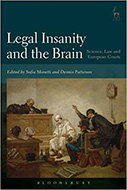LEGAL INSANITY AND THE BRAIN: SCIENCE, LAW AND EUROPEAN COURTS

Editors: Sofia Moratti & Dennis Patterson
Publisher: Oxford, UK; Portland, OR,Hart Publishing, 2016. 336p.
Reviewers: Michael L. Perlin & Alison J. Lynch | October 2017
When conversations about the insanity defense and the use of neuroscience in the court are twinned, we are struck by the opposite ways relevant information is processed. There is no question – at all – that the myths about the insanity defense have retained their staying power, in spite of unanimous valid and reliable evidence that refutes each one of them (evidence that has been available for decades), resulting in abnormal skepticism about the legitimacy of the defense on the part of jurors, judges and prosecutors (See e.g., Michael L. Perlin, The Insanity Defense: Nine Myths That Will Not Go Away, in The Insanity Defense: Multidisciplinary Views on Its History, Trends, and Controversies 1 (Prof. Mark D. White, ed.; Praeger, 2017)). On the other hand, there is similarly no question – at all – that the seductiveness of neuroscience testimony visual can dazzle jurors in ways that are inappropriately persuasive, thus leading fact-finders to subordinate their skepticism, as long as it is in line with their prior beliefs. In both instances, there is a constant: we teleologically privilege certain evidence and subordinate other evidence via the “confirmation bias,” through which we focus on information that confirms our preconceptions. The fact that neuroimaging appears “interesting” may make it more impressive and probative to jurors than clinical or actuarial testimony (the latter referring to the use and evaluation of specified predictors in a predetermined, numerical weighting system to determine future risk of re-offense).
It is thus vivid, and forces us to re-consider the dominance and the power of the vividness heuristic here and in all aspects of criminal law and procedure.
We have written about these phenomena separately and together; in a piece, that one of us (MLP) wrote 8 years ago, he asked whether “the seductive dazzle of colorful pictures will trump millennia of fear and superstition” and make the insanity defense more accessible to jurors, and concluded that, at that point, we couldn’t yet make a call, until we determined “to what extent will our prejudices, our stereotypes, our slotting, and our typification overwhelm all other evidence and all other issues in this conversation?” (Michael L. Perlin, “His Brain Has Been Mismanaged with Great Skill”: How Will Jurors Respond to Neuroimaging Testimony in Insanity Defense Cases?, 42 Akron L. Rev. 885, 914 (2009)). At the time, MLP was fairly confident that this topic – the relationship between the insanity defense and neuroscience – was poised to take off, and that there would be a bonanza of scholarship in the near future, noting that it raised “a variety of important and provocative legal, behavioral, and social issues, none of which has received nearly enough attention by the courts or by commentators.” (Id. at 915). But that has not happened. Since 2008, when the article in question was published, there have been only three other pieces in the legal literature about both topics; on the other hand, there have been hundreds of other articles dealing with neuroscience and neuroimaging as it relates to virtually every aspect of the law (see selected references).
That’s one reason we were so happy to have the chance to review this book, focusing, as it does on how “the rapidly changing knowledge emerging from neuroscience offers opportunities and challenges to the law, in particular in the context of insanity assessments” (p. viii, emphasis added). And it does just that. Sofia Moratti and Dennis Patterson’s book — collecting essays by a group of top-flight legal scholars from around the world — is an excellent comparative law study of how the insanity defense does or doesn’t operate around the world, and an excellent collection of articles about how neuroimaging is not a panacea for all that ails the criminal justice system. This bookis the first effort to consider these two halves in one overarching volume, and that, alone, is a major accomplishment.
The authors do an excellent job of remaining skeptical of neuroscience in most legal contexts, careful not to get drawn in by the dazzle or allure of colorful images and impressive technology. Throughout the book, they are quick to mention what neuroscience cannot do, a perspective that is frequently skimmed over or minimized in legal scholars’ excitement to insert neuroimaging into their field of law. (See e.g., p. 33 (chapter by Karponay and Koenigs)): “At this point in time, a neuroscientist cannot look at a neuroimaging scan and definitively conclude whether an individual qualifies as legally insane, nor can he definitively conclude that a particular abnormality contributed to a crime”).
The authors of several of the chapters also bring a unique perspective to what can, at times, seem like a somewhat stagnant debate about the place of scientific evidence in the criminal justice system (see e.g., p. 222 (chapter about the UK by Claydoin and Catley), speculating as to whether the insanity defense is underutilized); opening this debate up to include examples of how other nations are also grappling with these issues allows for a different kind of analysis than some America-centric legal scholarship. It is clear that the editors worked to integrate nuances of very different legal systems into their analysis, and this was generally a very effective way to bring new details to this debate. By way of example, Netherlands’ approach – incorporating five grades of criminal responsibility (see p. 160, chapter by Meynen) – has gone virtually unmentioned in the US-based legal literature (see Marijke Malsch & Ian Freckelton, Expert Bias and Partisanship: A Comparison between Australia and the Netherlands, 11 Psychol. Pub. Pol’y & L. 42 (2005) for one of the only prior mentions of this issue).
The articles and quotes from scholars around the world, showcased in this book, echo the authors’ more reserved excitement about the reach of neuroimaging evidence. Discussing practice in Belgium, for example, Hanouelle and Verbruggen argue that perhaps, given what neuroimaging is able to show, it might make sense to only use neuroimaging for purposes of lie detection (p. 67). Limiting the evidentiary scope of neuroscience is often not a popular argument, since many in the legal field believe that this type of evidence is not only ready for the courtroom, but the most effective way to prove a case. The editors, through their choice of opinions of other scholars, seem to argue that limitations are still necessary and responsible, since the “science” behind neuroscience evidence can often by misunderstood by juries and judges as well as by the counsel introducing it. An important point that is emphasized in several articles chosen by the editors is that, at this point, neuroscience cannot pinpoint the locus of behavior; that determination is far too complicated and intricate. Reducing that type of analysis to a single image or a series of images will only serve to perpetuate incorrect science and allow for others to rely on this type of factual inaccuracy in future cases.
This theme is continued in the articles focusing on the experiences in France and Italy. Here, the text argues that neuroscience might actually “reinforce the illusion” of our ability to predict behavior (p. 106, chapter by Bottalico and Santosuosso). Further, the authors argue, neuroscience may not have the sensationalized effect on the insanity defense that many may claim; such evidence may improve assessment of claims of insanity, but it will not revolutionize or transform the way the defense is used, because the science simply does not support it. Instead, neuroscience may have an impact upon punishment and treatment, allowing for a more tailored approach based on an individual defendant’s particular offense, history and, to some extent, data derived from neuroimaging (id., pp. 113-14). New neuroscientific technologies, according to these authors, “may be able to assist and integrate the methods of psychiatry into the assessment of mental illness and its impact on decision making, [thus enabling] a more fine-graded and individualized evaluation of individual capacity and a more personalized form of punishment,” id.
Although it is not mentioned specifically in this book, these insights go hand-in-glove with the school of legal thought known as “therapeutic jurisprudence,” a model that assesses the impact of case law and legislation, recognizing that, “as a therapeutic agent, the law that can have therapeutic or anti-therapeutic consequences.” (Perlin, supra note 2, at 912). In a recent article, the authors of this book review concluded that, “if used correctly, neuroimaging evidence could serve as a valuable tool for implementing therapeutic jurisprudence principles.” (Michael L. Perlin & Alison J. Lynch, “In the Wasteland of Your Mind”: Criminology, Scientific Discoveries and the Criminal Process, 4 Va. J. Crim. L. 304, 355 (2016)). The chapter by Bottalico and Santosuosso implicitly endorses these arguments.
Another critical point that the authors bring up in their examination of how neuroimaging is used and understood in the Netherlands is the need to have input from psychiatrists during the development of legal strategies that use neuroimaging (p, 161, chapter by Meynen). Not only is it important to select experts who are knowledgeable about the capabilities, and more importantly, the limits, of current neuroimaging technology, but it is just as important to involve those individuals in the implementation of novel legal strategies that bring neuroimaging evidence into the courts. Working with professionals in law and psychiatry, both groups of experts will be able to explain the constraints of their own fields, and come together to better understand how current capabilities of neuroscience can serve as additional evidence in appropriate cases. This approach, which relies first on strategy development, rather than “testing” uses of neuroimaging in court first, is another example of the more conservative tone taken in this work.
This is not to say that the book is Cassandra-esque in tone. It is measured and sober. And we think that that is a good thing. Again, in the Netherlands chapter, it seeks to calibrate the tension between over-enthusiasm and urgency (p. 163, chapter by Meynen). It acknowledges in the concluding chapter – and we agree – that neuroscience is likely to become more important in the future as a “more important tool for adjudicating the mental disorder criterion” (p. 271, chapter by Morse), but couples that with a warning against “irrational neurolaw exuberance” (id., p. 273). We believe that this balance between optimism and prudence strikes the exactly right tone for this topic.
Those interested in any aspect of criminal law and procedure and those interested in any aspect of scientific evidence will find this book worth their time and attention. Those who are particularly interested in the insanity defense will find in it a bonanza of new, provocative and thoughtful ideas. We are pleased to recommend it.
* Professor Emeritus of Law, New York Law School.; Founding Director, International Mental Disability Law Reform Project; Co-founder, Mental Disability Law and Policy Associates.
** Staff Attorney, Disability Rights New York; Associate, Mental Disability Law and Policy Associates.
Selected References
Melinda Corrido, Revisiting the Insanity Defense: A Case for Resurrecting the Volitional Prong of the Insanity Defense in Light of Neuroscientific Advances, 41 Sw. L. Rev. 309 (2012)
Andrew King-Ries, Arbitrary and Godlike Determinations: Insanity, Neuroscience, and Social Control in Montana, 76 Mont. L. Rev. 281 (2015)
Marijke Malsch & Ian Freckelton, Expert Bias and Partisanship: A Comparison between Australia and the Netherlands, 11 Psychol. Pub. Pol’y & L. 42 (2005)
Jane Campbell Moriarty, Seeing Voices: Potential Neuroscience Contributions to a Reconstruction of Legal Insanity, 85 Fordham L. Rev. 599 (2016)
Michael L. Perlin, “His Brain Has Been Mismanaged with Great Skill”: How Will Jurors Respond to Neuroimaging Testimony in Insanity Defense Cases?, 42 Akron L. Rev. 885 (2009)
Michael L. Perlin & Alison J. Lynch, “In the Wasteland of Your Mind”: Criminology, Scientific Discoveries and the Criminal Process, 4 Va. J. Crim. L. 304 (2016)


